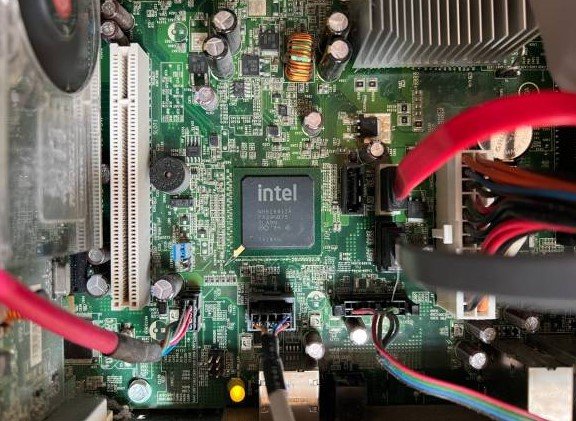Ken Shirriff, a well-known reverse engineer, has taken us deeper into Intel’s classic 386 processor than anyone outside the company ever has — thanks to a fascinating 3D computed tomography (CT) scan by Lumafield. This new glimpse shows the unseen complexity nestled within the chip’s ceramic package, revealing layers of wiring and power networks that go way beyond the silicon die itself.
Intel’s 80386 processor, introduced way back in 1985, marked a big step up in the x86 lineage. It was the first 32-bit chip in the family, packed inside a square ceramic shell with 132 shiny gold pins sticking out underneath, designed to slot into a motherboard socket. But, as Shirriff explains, this packaging isn’t just a simple box — there’s a hidden world of wiring and engineering marvels inside that package, now visible for the first time thanks to Lumafield’s scan.
Six Layers of Wiring and Two Power Networks: A Surprising Discovery
When people look at processors, they usually focus on the silicon die — the tiny chip at the center where all the transistor action happens. The packaging, including bond wires and pins, often gets ignored. But Lumafield’s CT scan changed that, peeling back the layers to reveal six distinct wiring layers inside the ceramic body of the 386.
What’s wild is that the 386 doesn’t just have a single power system. Shirriff found two separate power and ground networks: one dedicated to the input/output (I/O) side of things, and another powering the CPU’s logic core. This separation hints at clever design choices aimed at stabilizing operations and reducing noise between different parts of the chip.

He pointed out how the pins connect to the “shelf pads” on the package through broad metal traces, which are clearly visible in the scan thanks to false-color imaging. “These traces are surprisingly wide and free-form,” Shirriff mused, “I was expecting narrower traces to cut down on capacitance.” Those bond wires then make the crucial leap from the package’s pads to the silicon die itself, linking the outside world to the processor’s beating heart.
The 386’s Legacy: More Than Just an Old Chip
The Intel 386 isn’t just a relic. It was the backbone of PC computing for decades — launched in October 1985 and supported all the way until 2007. It introduced a 32-bit architecture and three operational modes: real mode, protected mode, and virtual mode. The last was especially interesting, allowing real-mode programs to run safely in a protected environment. This made multitasking and better memory management possible on early PCs.
While the die holds the transistor magic, this scan reminds us that the package itself is a masterpiece of engineering. The neat stacking of wiring layers, separated power planes, and complex routing ensures the chip runs smoothly in real-world conditions. Without such detailed connectivity, the processor wouldn’t function reliably or efficiently.
What Lumafield’s CT Scan Means for Reverse Engineering and Beyond
Traditionally, reverse engineers crack open chips by decapping the silicon and photographing it under microscopes. But they miss everything beyond the die — the tiny, delicate wires and traces that make electrical connections to the motherboard. Lumafield’s approach lets us peer non-destructively inside the sealed package in 3D, revealing how the chip interfaces with the outside world.
This tech isn’t just cool for nostalgia buffs or chip geeks. It could influence modern chip design by highlighting old-school packaging techniques still relevant today. Understanding how power is split and signals routed in a stable manner helps engineers create better, more reliable devices.
For Ken Shirriff, this is like adding a new dimension to his detective work on classic chips. His detailed blog and videos explaining these scans turn technical mysteries into engaging stories — shedding light on the marvels packed inside processors we thought we already knew inside out.
Peeking Beyond the Silicon: Why Package Design Still Matters
People often forget that a processor’s performance depends as much on how it’s packaged as on the transistors themselves. The physical connections — bond wires, pins, and power layers — must be carefully designed to minimize interference, resist heat, and ensure stable voltage supply.
In the 386’s case, the six-layer wiring and dual power networks reflect design goals that go beyond raw computing speed. These features help keep the chip stable during complex operations, especially as signals travel back and forth at lightning speed.
It’s like looking under the hood of a vintage car and discovering a surprisingly intricate wiring loom that’s held up for decades. Sure, the engine matters most, but without clean, organized wiring, the whole machine falls apart.
The CT Scan Table: A Snapshot of the 386’s Wiring
| Feature | Description |
|---|---|
| Wiring Layers | 6 layers of metal wiring inside the package |
| Power Networks | 2 separate sets for I/O and CPU logic |
| Package Pins | 132 gold-plated pins connecting to motherboard |
| Bond Wires | Tiny wires linking package to silicon die |
| Material | Ceramic package with gold-plated pins |
This table sums up the unique wiring features uncovered by the CT scan, highlighting the unexpected complexity hidden in what seemed like a simple chip package.
Ken Shirriff’s exploration through Lumafield’s scan gives us a fresh perspective on a classic processor — one that revolutionized computing and still teaches engineers lessons about design and integration today.








